How Much Does Personal Training Cost?
In-Person, Online AND Everything In-Between



No matter how many coaches I talk to, the same questions always comes up in conversation: how much should I be charging?
There can be an automatic “it depends” response attached to that questions but it gets asked so much for a reason. Most coaches out there really have no idea how much they should be charging.
Nobody (and I mean NOBODY) wants to feel like they are being paid less than they deserve. It’s a shitty feeling to think you aren’t being valued they way you truly believe you should be. For this reason, coach David Otey and I have teamed up to give you the rundown on how to navigate your hourly rate.
The Foundation – The Fitness Industry
Check out the full details for this graph on the PTDC HERE
Lets be very clear from the jump – this is a service industry. That means there is a multi-factorial approach to understanding how much is the “right” amount to be charging someone in personal training.
For the love of god, don’t go to Glassdoor and look up how much a personal trainer should be making. In my area, the average Personal Trainer should be making around $60k according to them and national average is around half of that (just over $30k).
What!?
No wonder so many coaches out there are charging below what they should be.
I don’t know about you but I have never qualified myself as “average” by any comparison of what I do from a day to day basis. There is nothing average about what trainer’s can provide for their clients from detailed preventative measures to life enhancing programs.
Personal Training has gotten a crappy rep for a long time as a career choice and we are here to take a stand and say – fuck that.
Value is a measure of social qualification meaning how much personal training is worth is 100% based on the perception of the public and what we as practitioners bring to the table – so lets fix that!
Deciding Your Personal Training Rate
I know, this can be a tough conversation with yourself if you aren’t used to debating what you deserve. For that reason, I am going to give you 5 direct categories to help you better gauge how much you should be charging for your time. Those categories are:
-
Current Local Rate
-
Level of Experience
-
Distance Traveled
-
Level of Service
-
Challenge of Scheduling
Using these 5 Criteria it should be an easy way for your to troubleshoot the process and figure out what is the most appropriate hourly rate for yourself. A system like this allows for adjustment based on where you are, when you are training, location of sessions, etc.
So ditch the guessing game and start to approach your sessions with more certainty to create a truly reliable career.
Current Local Rate
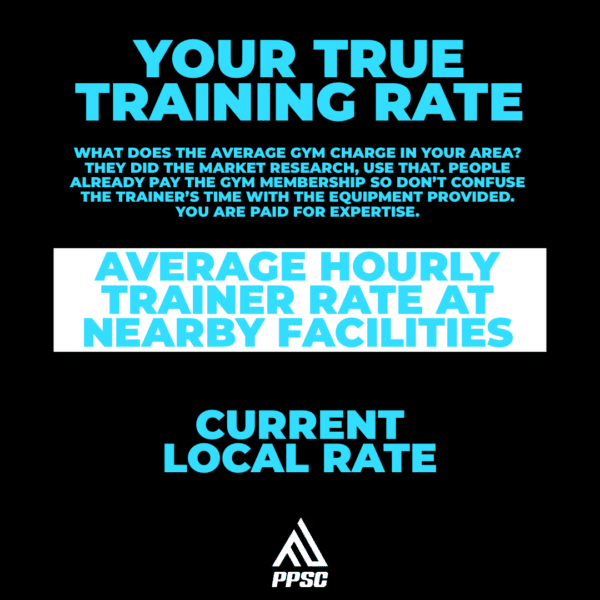
If you are training in a certain region anywhere in the world, it’s important to know what the going rate is within a 15 mile radius. Without this information, you are really operating in the dark.
The current local rate is the baseline number you can operate off of when creating your hourly rate from the beginning. Plenty of big box gyms have already done hours and hours of market research to find out what the appropriate number is – so use that.
Finding this number shouldn’t be difficult either. Contact or find out the pricing from 5 of the local gyms in the area by you.
These gyms should range from luxury facilities to smaller boutique training studios. This is going to give you a range of numbers to look at and evaluate where your service will be sitting at.
To start – it would be most appropriate to use that number that is the mode of the 5 prices (most frequent). This will give you a baseline of what the common dollar amount is and where you can begin your journey.
Keep in mind, the remaining four variables will adjust the price up or even down based on the other things you are bringing to the table. Honestly, rarely does the price go down from here unless you are teaching jumping jacks in the park.
Level of Experience
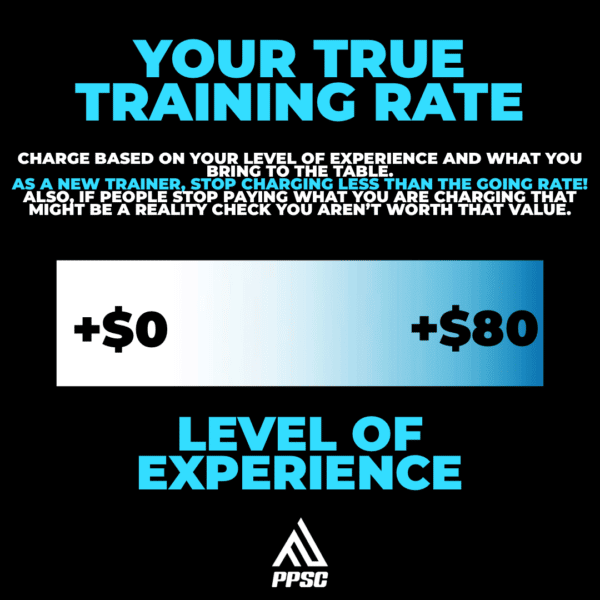
This is where I see the most trouble. Usually, not in the way you would imagine.
“I know I am a new coach and I don’t have a lot of experience so I only charge X amount”
NO, NO, NO, NO, and NO.
One of the most fundamental parts of value in a service is understanding that you are providing that service. That means, I don’t care if you got certified YESTERDAY – if the going rate for training is $60/hr you should be charging $60/hr.
You are a CERTIFIED PROFESSIONAL. Embrace it!
Not to mention with private training outside of a facility you should be charging more in general because of the customized experience you can provide for them (we’ll talk about this in the service section).
Experience should also be a blend of education and hours practice. Years in the industry unfortunately doesn’t hold as much weight as people would think. So to categorize this one we have 5 levels:
- New – +$0
- Seasoned Trainer – +$20
- Highly Sought After – +$40
- One of the Best in your Region – +$60
- One of the Best in your State/Province – +80
This add on with go on top of the baseline hourly wage from your area.
Also, be honest with yourself in your ranking. Not everyone is best in a 100 mile radius and that’s okay. Most importantly, know your worth and identify how to move up the chain.
Distance Traveled
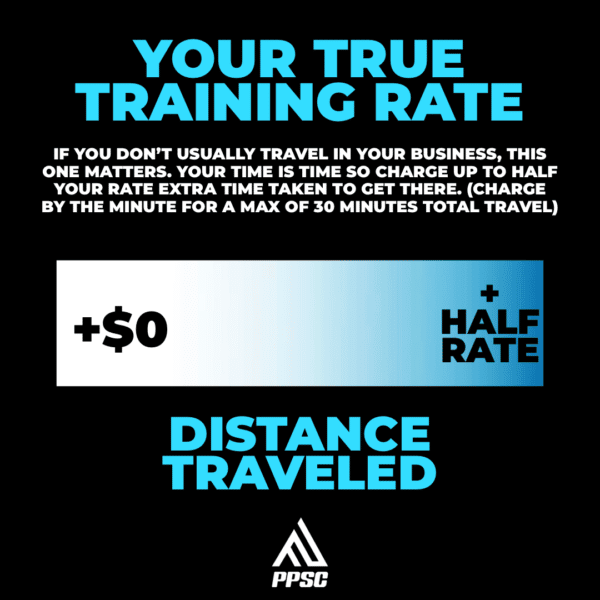
If you are working with a private client, you have to remember time is money. The hourly rate you are charging is going to go hand in hand with how much time this is absorbed by working with this person.
Operating out of your home gym can be a great move but understand you can’t up your fee for someone driving to you.
However, if someone is going to ask you to travel to them – that’s a different story.
This is where you would extend your hourly rate for up to 15 minutes on each side. The maximum I would add is 1/2 of your hourly wage if you are traveling 30 minutes of more total to that person and back home.
To be completely clear – you shouldn’t charge someone more if you are a travel only operator or work in a dense city like NYC where it is already expected. In those circumstances, the base rate is already much higher because of the anticipated travel.
But for the instance you have someone that doesn’t want to come to you and wants you to train them in their home, that would cost extra. This means equipment traveling, eating into your schedule, disrupting time you could be training others.
Be realistic when it comes to this variable. Don’t outprice yourself because you are being greedy.
Level of Service
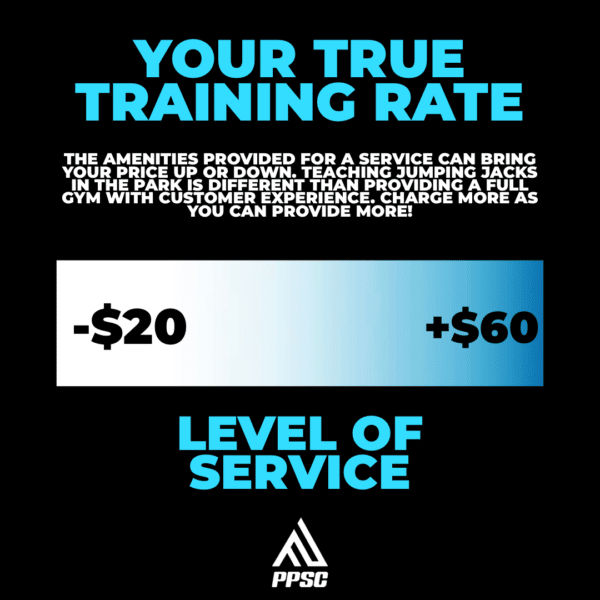
What kind of experience are you providing for the clients you work with?
The amenities can completely change how people view training with you compared to others. It’s the differentiator in value.
If they train at your home gym, do you have:
- Full Gym
- Towels
- Music (they can choose the playlist)
- Energy Drinks
- Protein Shakes
- Air Conditioning
Those all MATTER, a lot.
The better you can customize their experience the more you should be charging for your time. The energy drinks, clean towels, protein shakes – they aren’t free.
But if I asked you would you rather have all that readily available for you in a workout and you can listen to whatever the hell you want I bet most of you would be on board.
The experience is everything. The better you can customize that experience the more valuable your time and space are!
Challenge of Scheduling
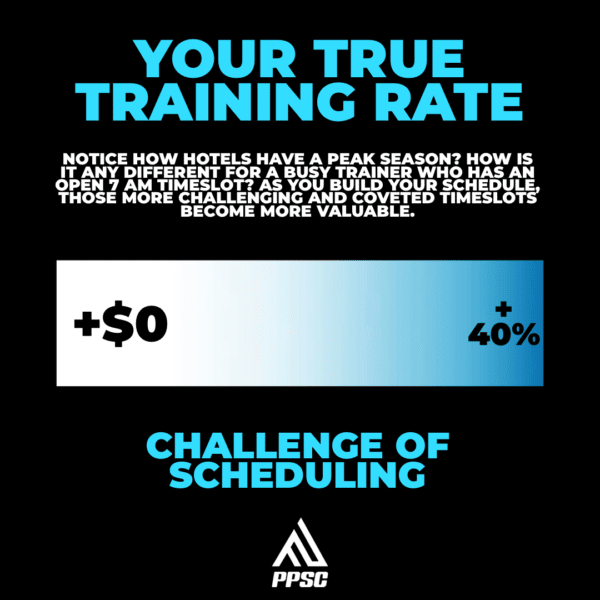
Ever try to book a beach vacation in the middle of summer? Oh, it’s more expensive than during the fall? That’s because of demand.
How many clients have ever asked you, “I want to train on Monday’s and Wednesday’s at 5:00pm!”
Sweet, get in line with the rest of them. That’s a prime spot!
Your time should be just as valuable and shouldn’t waver on that. Especially if someone is demanding to book on the half hour and that would ruin a 2-hour timeslot for you to accommodate this one person. I personally wouldn’t suggest that but I have seen it happen.
Find a way to collaborate with the client and let them know when you are free and when you are not. With a wide open calendar, you shouldn’t be upselling the 7:00am timeslot. Once you already have 30 sessions per week and people are all eyeballing that 7:00am timeslot, then you can talk.
What It Looks Like
With all 5 categories taken into consideration it’s time to figure out what the realistic rate is for you.
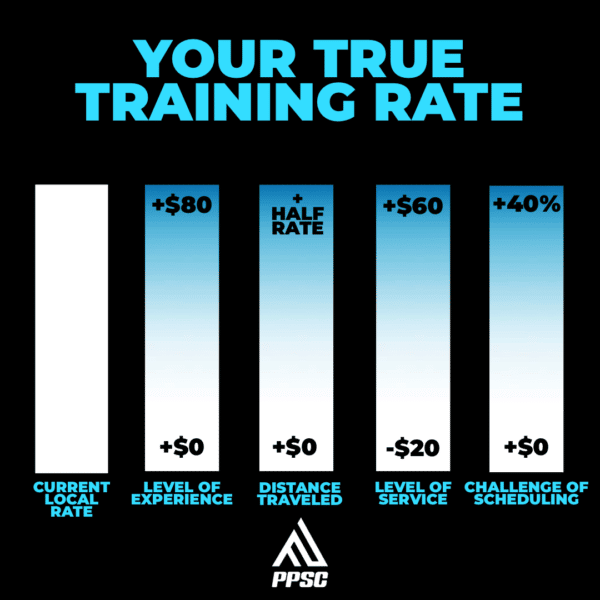
Example 1 – If the going rate for training in your area is $50/hr. That is where we start.
Okay, I am a new trainer so I would add nothing on top of that from the experience side.
I have a gym ready for them but they want me to train them at their house which is 10 minutes away from mine (20 minutes total). This would be an additional ($50/hr*33%=$16.50) so the new rate for that person would be $66.50.
I have adjustable dumbbells and bands I bring to the session which is the right amount of equipment and they chose an ideal timeslot.
For this client, I would charge $66.50/hr
Example 2 – If the going rate for training in your area is $50/hr. That is where we start.
I have 10 years experience and multiple certifications. I am a master trainer at my previous facility. I would add $30/hr to my rate.
I travel no distance because they are coming to my home gym so my travel is from the couch to the garage. Add $0
I provide Protein Shakes and towels as well as they can choose their music. Add $20/hr.
They chose a timeslot that has been open so add no additional money.
Their training hourly rate is $100/hr for this client
Just remember, this isn’t a scale to squeeze the orange for all its juice. This is to make sure YOU are being paid accordingly. I wouldn’t implement this with all existing clients immediately (that’s how you create a lot of conflict) but any new clients coming up should be under this model.
And whenever you are in doubt, ask in the PPSC Coaches Group what other people are charging until you get comfortable with this model.
Online Training

This is an extremely hot topic in today’s fitness industry that saw many professionals forced into a virtual and online space over the last 16 months due to in-person restrictions.
But for real? If you’re a coach who is training clients online, what should you be charging? It’s not as simple as a single one size fits all number. Actually, it’s not as simple as charging what you’re worth, either…
Online Training vs. Virtual Training

Lets start with what ONLINE TRAINING actually is. Online training is a service provided by fitness professionals to remote clients. Online training consists of setting up a personalized and custom training program, delivering it AND coaching it up through remote NON-real time communication like direct messages, emails, chats to ensure quality execution, loading, recovery etc.
If you’re thinking “yeah, no shit!” stay with me here. Online training and VIRTUAL training are two different things. So what is virtual training? The delivery of a REAL-time training session by a fitness professional with a remote client. Including programming, coaching and of course, communication.
Think of virtual training as almost exactly the same as in-person training, just instead of being in the gym physically with that client during their training session, you are on a screen with that client while they are training, again in REAL-time.
Before we get into what online training should cost, lets discuss virtual training costs. This one is simple, virtual training sessions should cost the SAME as in-person training sessions. They should not cost LESS. If anything, they should be valued MORE due to the elimination of many barriers of entry and execution by the client.

Depending on your expertise, market, and of course, NETWORK, virtual training should cost anywhere from $80-250 per session. Not per month, but per session.
These clients should be training with you at the same frequency as in-person clients. So likely 2-3 days per week for 80% of them. And for those select 20% of outlier clients, you’ll train them 4-5 times per week on average.
Lets do some quick math here. At the low end of virtual training, each client training on average 3 times per week is worth approximately $1000 per month in revenue.
And at the high end? Each client is worth approximately $3000 per month.
Again, this is NOT online coaching, this is VIRTUAL coaching.
Online Training Pricing
So what about online training? How does this compare? You may be thinking to yourself, “Damn, I need some virtual training clients!” and yes, you are probably right. But many times, the same restrictions as in-person training are present. Mainly scheduling conflicts and commitment levels.
We can simply eliminate scheduling issues and also price and/or frequency challenges by offering an online training solution allowing clients to train whenever they’d like (without you needing to be there with them in-person or on the computer) and also make it more affordable for them to train with you as compared to again, in-person or virtual.
If this is the model you’re interested in using, this is my pricing hierarchy of what online training should cost in tiers:

An expert coach is one who you likely read their articles, go see them speak at major conferences or certification courses, and have a long track record of world-class results and respect in the industry for doing a tremendous fucking job. They are the elite.
A quality coach not only gets the job done, but are true professionals in the field. Maybe they don’t have the “big name” of an elite expert coach, but they are masters of the craft.
A newbie trainer (not a bad thing, everyone’s been here) is a fitness professional with 1-3 years of experience IN-PERSON training clients. They are still learning, and leveling up their knowledge and expertise each day.
A fitness hobbyist is NOT a coach. They are someone super into workout out and training. They don’t have the knowledge in program design, client management, exercise science, or anything for that matter, but they are into helping people get moving and get active.
And the bottom rung? Fake ass IG influencers who are young, inexperienced, immoral, unethical and all around offer the shittiest possible product via lying and cheating their way into your bank accounts on a monthly basis. They sell their ass as a way to convince people they can do it too.

I hate these people, they are what’s wrong with the industry. And they are taking away from the great fitness professionals working to make an impact on real clients with real health and fitness goals.
OK, so I got that off my chest. But here’s the cold hard facts. Managing an online training client (well) takes about 20 hours per month of time investment to program, coach, fine tune, check in and manage that person.
So keeping this in mind, here’s what that breaks down to from an hourly basis on the hierarchy of online training costs:
Tier 1: Elite Expert Coach – $45 per hour
Tier 2: Quality Coach – $30 per hour
Tier 3: Newbie Trainer – $17.50 per hour
Tier 4: Fitness Hobbyist – $7.50 per hour
Tier 5 Fake Ass IG Influencer – $2.50 per hour
Those numbers should be SHOCKING to you. “But I thought you get rich online training?!” was the idea we’ve all been sold from online fitness business coaches and marketers.
But online training does not break principles of business and finance. You can only charge what you’re worth, and you only have so much time to delivery quality and consistent coaching and programming to your clientele.
Closing Thoughts

So what does this mean for you as a coach? Easy, charge what you’re worth, and find a clientele that values you. DO NOT DISCOUNT. Look above, you’ll be working for $10 per hour and hate life and probably end up not continuing on this path.
For clients, do NOT think you’re going to receive a world-class product for $10 per hour. You cannot buy a Ferrari for the price of a Prius. That’s not how the world works, and if you’re truly invested in your health, wellness and longevity, paying MORE is 100% worth it in the long run, any way you look at it.
It all comes back around to expertise, respect, and VALUE. Value yourselves as fitness professionals, continue to increase your VALUE over time, and charge what you are WORTH.
In a superficial world of sleazy sales, misinformation marketing and a major lacking of moral compass, be the change. Be the difference maker. And help lift yourself up above the shit storm.

Dr. John Rusin is a sports performance specialist and injury prevention expert that has coached some of the world’s most elite athletes, barbell sport competitors, and over 10,000 clients from all walks of life with his innovative pain-free performance programs and systems, which has gained him the reputation as the go-to industry expert for rebuilding after pain, injuries or plateaus. Dr. Rusin is also the founder of the Pain-Free Performance Specialist Certification (PPSC) that has certified over 10,000 personal trainers, strength coaches and rehab pros from across the globe in the pain-free performance training system since 2019.








